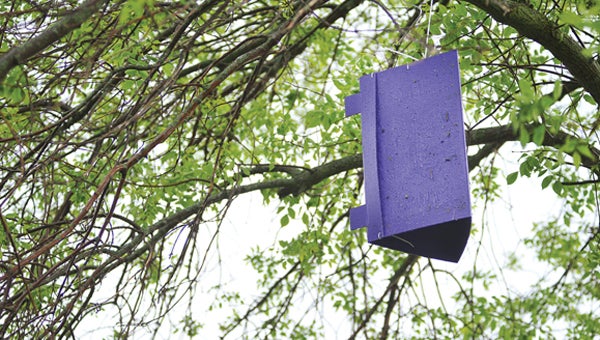City braces for ash borer infestation
Published 10:20 am Thursday, August 2, 2012

Emerald ash borer traps like this one are up around Austin, but the insect hasn’t been found in Mower County. -- Herald file photo
Austin is preparing its defense against what could be its smallest adversary.
The Austin Park and Recreation Department Board Wednesday approved a motion to change a city ordinance to prepare for an invasion of emerald ash borers, small insects that burrow inside and kill ash trees. The ordinance originally served to protect trees only from diseases, specifically Oak Wilt and Dutch Elm.
“Our ordinance was a shade tree disease [ordinance],” said Kim Underwood, director of Park and Rec, adding that now it will be suited to pests as well.
Underwood said the city has the authority to order residents to remove trees infected with Dutch Elm Disease on their property because these trees pose such a threat to others. The same would likely go for ash borers.
The changes, which include adding “ash trees” and “pests” to the language of the ordinance, require a few more steps. The Austin City Council will first discuss the proposed changes at a work session, which could happen this month. After that, the council would need to approve it as a resolution at a council meeting.
Underwood said there are no confirmed cases of ash borer in the Austin area, but about 17 percent of the trees on public property in the city are ash trees, and would be susceptible. There’s no estimate of how many ash trees there are on private property.
The ash borer has so far been found in Hennepin, Houston, Ramsey and Winona counties. According to entemologist Mark Abrahamson with the Minnesota Department of Agriculture, people can spread the ash borer much quicker than the pest can travel on its own.
And because the pest takes a long time to kill a tree, it could easily go three years undetected. So Park and Rec, the DNR and MDA are keeping watchful eyes. Abrahamson added that it’s very hard to predict where the pest will spread, as moving infected firewood tends to be the leading cause of transport.
Minnesotans can help prevent the ash borer’s spread by not moving firewood or other parts of ash trees to new locations. They also can report suspicious insects or trees to Park and Rec by calling 507-433-1881 or the MDA by calling 800-967-2474.
The ash borer is between 3⁄8 and a half an inch long, with a large head and big eyes. It has green wings and a bright magenta body, Underwood said. The pest does look very similar to a much less threatening insect, and often people will bring her examples of a look-alike concerned that it is the ash borer.
According to the University of Minnesota’s website on ash borers, ash trees have no natural defense against the pest. Residents can look for an 1⁄8 inch, D-shaped hole on the bark of a tree. Ash borers slowly kill trees, and typically the top of the tree will die first.
The insects take flight in April and May, which is when they are most likely to spread on their own. As the insects are native to Asia, they have few natural predators here to keep them in check, according to the Minnesota Department of Agriculture.
—Matt Peterson contributed to this report.


